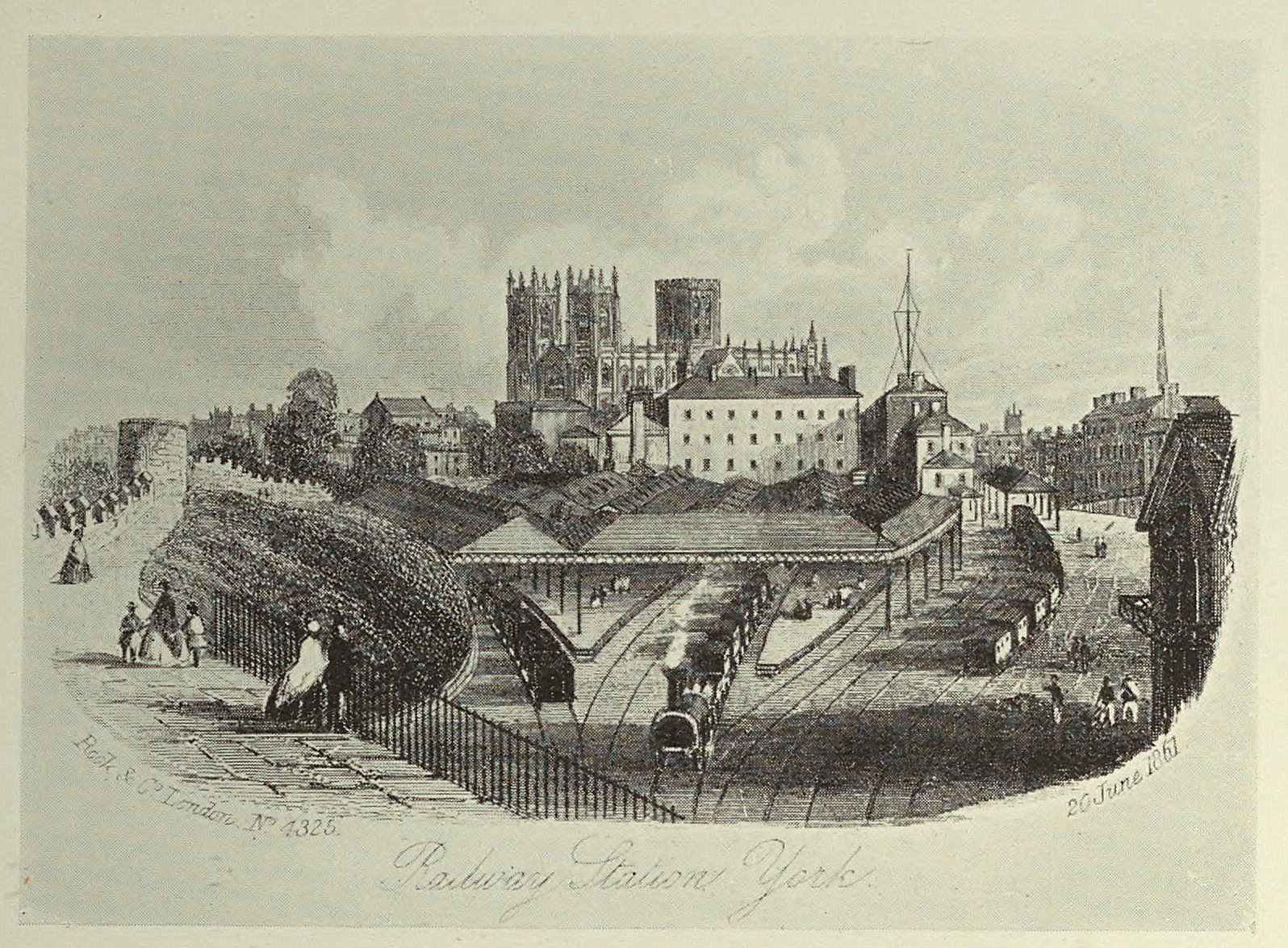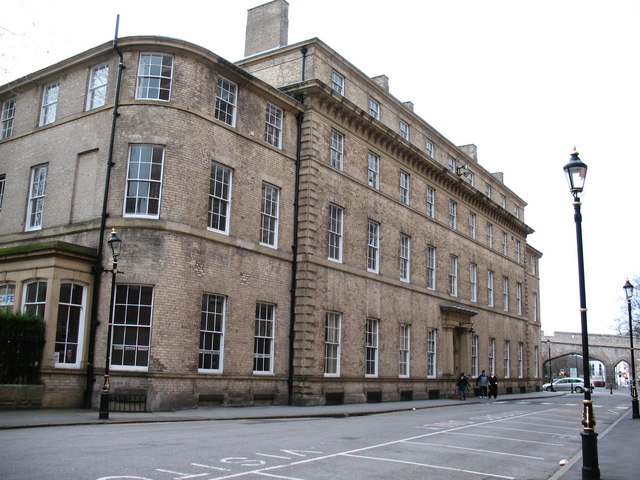York Old Railway Station on:
[Wikipedia]
[Google]
[Amazon]
 York old railway station is a former
York old railway station is a former
 The first York railway station was a temporary building on Queen Street outside the walls of the city. It was opened in 1839 by
The first York railway station was a temporary building on Queen Street outside the walls of the city. It was opened in 1839 by
 Andrews also designed the hotel across the head of the lines on Station Rise. This was completed in 1853 and was the first hotel to be incorporated into a railway station. After a visit by
Andrews also designed the hotel across the head of the lines on Station Rise. This was completed in 1853 and was the first hotel to be incorporated into a railway station. After a visit by
 York old railway station is a former
York old railway station is a former railway station
Rail transport (also known as train transport) is a means of transport that transfers passengers and goods on wheeled vehicles running on rails, which are incorporated in Track (rail transport), tracks. In contrast to road transport, where the ...
in the city of York
York is a cathedral city with Roman origins, sited at the confluence of the rivers Ouse and Foss in North Yorkshire, England. It is the historic county town of Yorkshire. The city has many historic buildings and other structures, such as a ...
, England
England is a country that is part of the United Kingdom. It shares land borders with Wales to its west and Scotland to its north. The Irish Sea lies northwest and the Celtic Sea to the southwest. It is separated from continental Europe ...
. It is a Grade II* listed building
In the United Kingdom, a listed building or listed structure is one that has been placed on one of the four statutory lists maintained by Historic England in England, Historic Environment Scotland in Scotland, in Wales, and the Northern I ...
.
Origins
 The first York railway station was a temporary building on Queen Street outside the walls of the city. It was opened in 1839 by
The first York railway station was a temporary building on Queen Street outside the walls of the city. It was opened in 1839 by George Hudson
George Hudson (probably 10 March 1800 – 14 December 1871) was an English railway financier and politician who, because he controlled a significant part of the railway network in the 1840s, became known as "The Railway King"—a title conferr ...
's York and North Midland Railway and was the terminus of the original trunk route for trains to London
London is the capital and List of urban areas in the United Kingdom, largest city of England and the United Kingdom, with a population of just under 9 million. It stands on the River Thames in south-east England at the head of a estuary dow ...
, via Derby
Derby ( ) is a city and unitary authority area in Derbyshire, England. It lies on the banks of the River Derwent in the south of Derbyshire, which is in the East Midlands Region. It was traditionally the county town of Derbyshire. Derby g ...
and Birmingham
Birmingham ( ) is a city and metropolitan borough in the metropolitan county of West Midlands in England. It is the second-largest city in the United Kingdom with a population of 1.145 million in the city proper, 2.92 million in the We ...
.
It was succeeded by what is now the old station, built at the junction of Toft Green, Tanner Row and Station Rise inside the city walls by the Y&NM's architect George Townsend Andrews in 1840. It opened on 4 January 1841. Andrews also designed the neo-Tudor arch where the walls were breached to allow trains to access the station.
The building
The station was built in an Italianate style. Its main facade, a symmetrical seventeen-bay three-storey block, faces Tanner Row and Toft Green. The ground floor is ofcarboniferous
The Carboniferous ( ) is a geologic period and system of the Paleozoic that spans 60 million years from the end of the Devonian Period million years ago ( Mya), to the beginning of the Permian Period, million years ago. The name ''Carboniferou ...
limestone
Limestone ( calcium carbonate ) is a type of carbonate sedimentary rock which is the main source of the material lime. It is composed mostly of the minerals calcite and aragonite, which are different crystal forms of . Limestone forms w ...
and the upper floors are brick with stone dressings. Behind this are the remains of the train-shed, which was of iron construction and was largely demolished in 1965. Beyond the shed, by the city wall, are brick buildings which housed the refreshment rooms and waiting room
A waiting room or waiting hall is a building, or more commonly a part of a building or a room, where people sit or stand until the event or appointment for which they are waiting begins.
There are two types of waiting room. One has individuals ...
s. They originally consisted of only one storey, but an upper storey was added in 1850.
 Andrews also designed the hotel across the head of the lines on Station Rise. This was completed in 1853 and was the first hotel to be incorporated into a railway station. After a visit by
Andrews also designed the hotel across the head of the lines on Station Rise. This was completed in 1853 and was the first hotel to be incorporated into a railway station. After a visit by Queen Victoria
Victoria (Alexandrina Victoria; 24 May 1819 – 22 January 1901) was Queen of the United Kingdom of Great Britain and Ireland from 20 June 1837 until her death in 1901. Her reign of 63 years and 216 days was longer than that of any previ ...
, it was named "The Royal Station Hotel".
Closure and afterlife
With the rapid increase in the number of new railway lines during therailway mania
Railway Mania was an instance of a stock market bubble in the United Kingdom of Great Britain and Ireland in the 1840s. It followed a common pattern: as the price of railway shares increased, speculators invested more money, which further increa ...
and later, this station, originally a terminus, became a part of the route from London to Newcastle and beyond. Through-trains calling at York had to reverse out of the station to continue their journeys, an inconvenience to railway staff and passengers, and a new through station (the present York railway station
York railway station is on the East Coast Main Line serving the city of York, North Yorkshire, England. It is north of and on the main line it is situated between to the south and to the north. , the station is operated by London North Ea ...
), outside the city walls, was planned and eventually built, opening in 1877. The tracks into the old station, however, remained in use for a further 88 years as carriage storage space. Meanwhile, the railway buildings and hotel were converted into offices.
In February 2010, the City of York Council announced that it intended to convert the station into its new headquarters, to be known as the West Offices. A planning application was submitted, and was approved in June 2010. English Heritage
English Heritage (officially the English Heritage Trust) is a charity that manages over 400 historic monuments, buildings and places. These include prehistoric sites, medieval castles, Roman forts and country houses.
The charity states that i ...
and York Civic Trust supported the proposal. Following objections by the Victorian Society to some aspects of the conversion, the application had to await a decision of the Secretary of State, but it was eventually approved and work on refurbishing the building was completed in April 2013. A 'Topping Out' ceremony was conducted by construction and project teams from York Investors LLP, Miller Construction and City of York Council on 17 November 2011. The council moved in during the spring of 2013. An official opening ceremony was conducted on 20 September 2013.
References
{{coord, 53.9583, -1.0894, type:railwaystation_region:GB, display=title Disused railway stations in North Yorkshire Grade II* listed railway stations Grade II* listed buildings in York Former North Eastern Railway (UK) stations Railway stations in Great Britain opened in 1841 Railway stations in Great Britain closed in 1877 Former York and North Midland Railway stations George Townsend Andrews railway stations 1877 disestablishments in England 1841 establishments in England